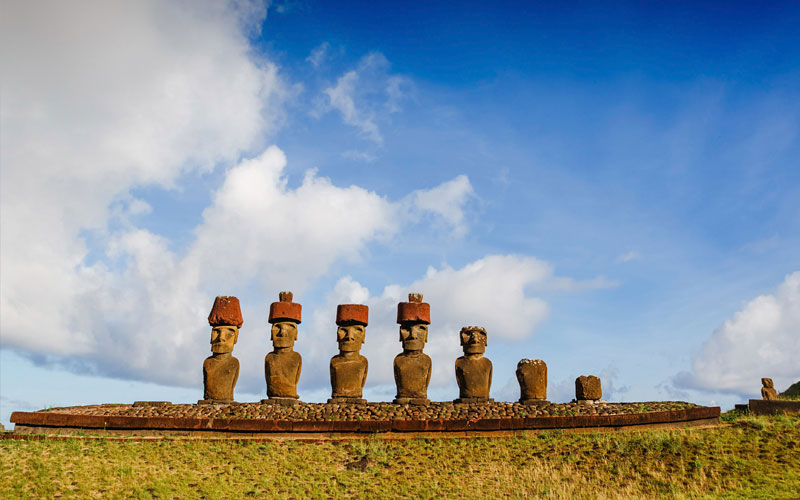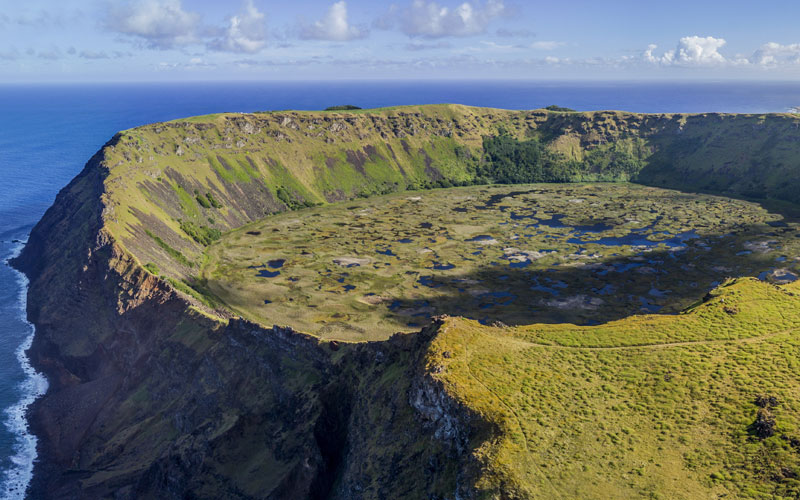Hotel pick up & drop off
Private transportation
Private tour guide (Bilingual Spanish/English)
Bottled water
Experience the essence of Rapa Nui with our "Highlights Route" tour. Begin your journey at the idyllic Anakena Beach, where Ahu Nau Nau showcases beautifully restored moai statues. Prepare to be mesmerized by Ahu Tongariki, an awe-inspiring sight with 15 majestic moai standing proudly against the stunning Pacific backdrop. Explore Rano Raraku, a mystical moai quarry adorned with approximately 400 scattered statues, revealing the island's remarkable craftsmanship. Delve into the mysteries of Ahu Akivi, home to seven intriguing moai statues that hold captivating tales.
Marvel at the breathtaking Rano Kau crater and its exquisite lagoon, offering a picturesque vista that will leave you spellbound. Conclude your journey at Orongo, where the ancient legends of the Birdman cult spring to life through captivating petroglyphs and fascinating archaeological ruins. Immerse yourself in the enchanting allure of Rapa Nui's natural beauty and cultural heritage as our remarkable tour unveils the secrets of this extraordinary island.
ANAKENA BEACH
Rapa Nui, Chile
Anakena Beach is revered as the historical and cultural cradle of Easter Island. Legend has it that the first king, Hotu Matu'a, landed here, establishing the initial settlement of Rapa Nui culture. Initially named Hanga Mori or One, it was later dubbed Anakena after a nearby cave. This beach evolved into a significant population center and a crucial site for the Miru tribe. Anakena boasts vital archaeological remains dating back to 1200 AD, including ceremonial centers, residential areas, and Ahus (ceremonial platforms). Notable among these are Ahu Ature Huki, featuring a single moai, and the impressive Ahu Nau Nau, adorned with seven finely detailed Moai. The latter, restored in 1978, is a remarkably preserved complex, as its Moai were protected from weathering by being buried in sand.
AHU TONGARIKI
Rapa Nui, Chile
Ahu Tongariki, the grandest and most imposing monument of Rapa Nui, is believed to be a sociopolitical and religious center dating back to 900 AD. The Ahu at Tongariki is the largest ceremonial structure on the island, holding 15 moai, representing the zenith of Rapa Nui's constructions. Once devastated, the site has been meticulously restored, allowing visitors to witness the megalithic structures in a state akin to their original splendor. The 15 giants, each with unique shapes and sizes, stand on a 100-meter-long altar, providing spiritual protection to the ancient village. The restoration has allowed for the observation of the wonderful structure, showcasing the diverse characteristics and expressions of the statues, reflecting the features of each ancestor and the evolution of their stylized features over time.
RANO RARAKU
Rapa Nui, Chile
Rano Raraku is the monumental volcanic quarry that served as the production site for the iconic moai statues. Composed of unique volcanic tuff, it provided the raw material for sculptors to create the nearly 1,000 statues found on the island. The quarry's southern slope is adorned with dozens of stone heads and figures, showcasing the remarkable craftsmanship of the ancient sculptors. The presence of numerous unfinished statues and empty niches signifies the quarry's pivotal role in the island's cultural and ceremonial practices.
AHU AKIVI
Rapa Nui, Chile
Ahu Akivi, is unique due to its location, astronomical orientation, and the restoration work that marked a milestone in the island's recent history. It is the most significant interior Ahu, associated with the powerful Miru clan, featuring seven carefully crafted Moai, indicative of political stability and economic abundance. The statues were transported 15 km from Rano Raraku quarry and are facing the sea, unlike others. The seven statues are thought to symbolize the island's first explorers or ancient Polynesian kings.
RANO KAU
Rapa Nui, Chile
Rano Kau with its almost circular crater forms one of Rapa Nui's most stunning natural landscapes. Spanning 1.5 kilometers, the crater houses the largest reserve of endemic flora on the island, while its lake served as a vital source of drinking water. Additionally, obsidian, found primarily in Maunga Orito and Maunga Te Manavai, was a valuable resource used for crafting various tools and artifacts. Rano Kau's serene ambiance, accompanied only by the sounds of wind and distant waves, makes it a must-visit destination.
ORONGO
Rapa Nui, Chile
Orongo was the location of the ancient ritual known as the Tangata Manu competition. This ritual, held in honor of the creator god Make Make, determined the Tangata Manu or Birdman of the season, granting the winner rights and privileges over rivals. The site's first constructions were built around 1400 AD, with houses specially constructed for the competition. The village's surroundings are adorned with over 1,700 petroglyphs, making it the place with the highest concentration of rock art on the entire island. The competition involved representatives from different clans descending the cliff, swimming to Motu Nui, and waiting for the arrival of seabirds to obtain the first Manutara egg, signifying the chosen Tangata Manu. This tradition emerged when the old political and religious order lost prestige, and opposing tribal groups competed for power.
Stops
13
Duration
Full Day
Group size
4
Difficulty
Easy

















